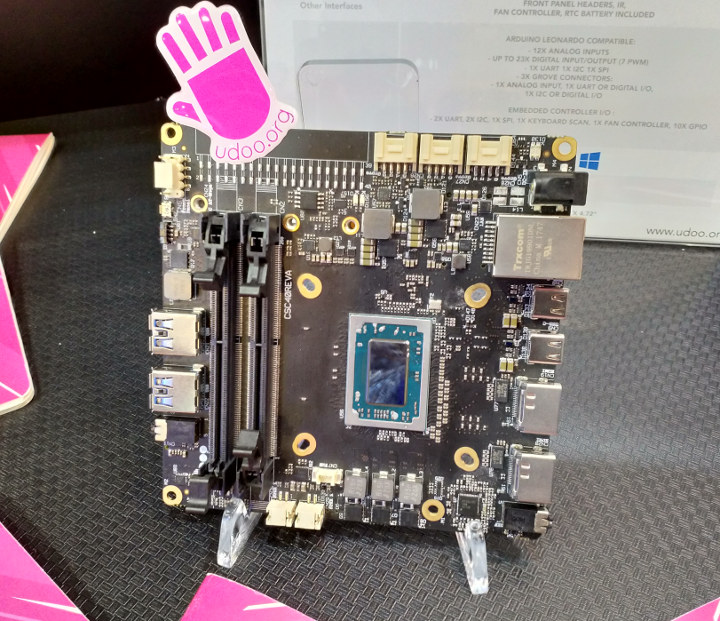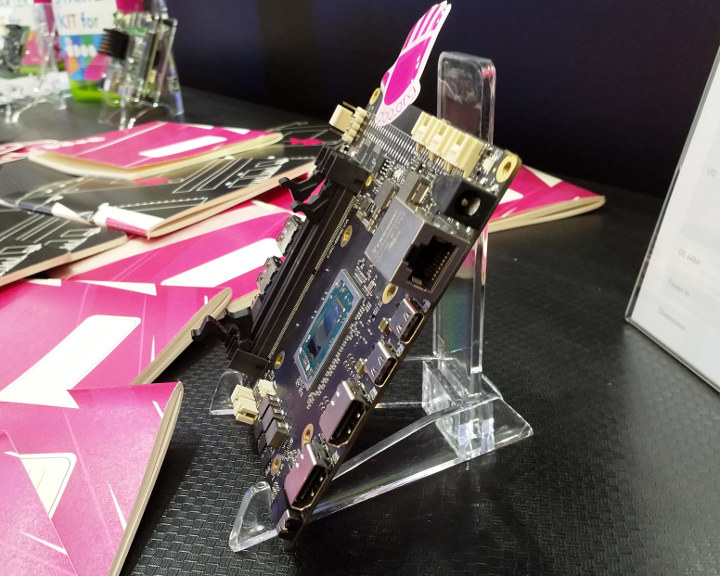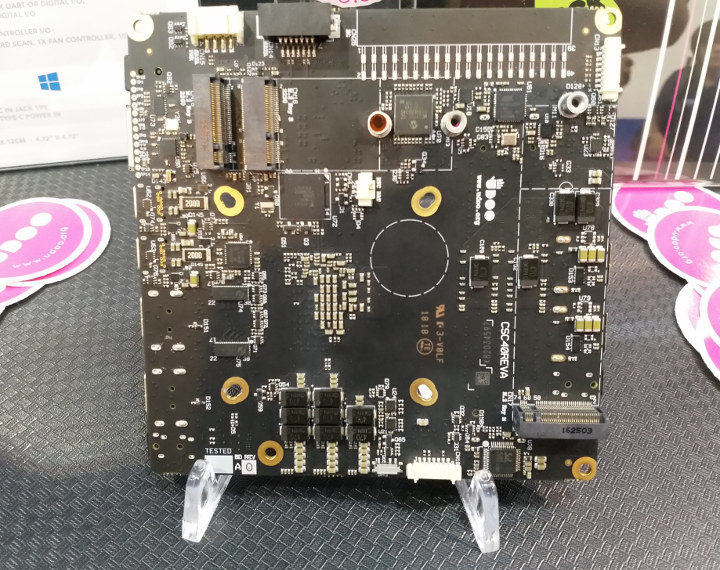The first AMD Ryzen Embedded V1000 development board – UDOO Bolt – was launched on Kickstarter last week, but for whatever reasons, the company did not provide close up photos of the board.
But luckily for us, TLS – regular reader & commenter, and occasional contributor for CNX Software – is now at Computex 2018 and spent some time at UDOO’s booth where he took time to take some photos and share with us.

The top view of the board shows the two SO-DIMM slots and Ryzen Embedded processor, as well as an better looks at the ports and headers around the boards.

The board should support up to 4 displays via its two HDMI 2.0a ports, and two USB type C ports with DP alternate mode. While, AMD Ryzen Embedded V1000 SoCs support 10 GbE, UDOO selected TRXCOM TRJG19901DNL Gigabit Ethernet jack, probably to keep costs under control.

The bottom side reveals the M.2 Key B 2260 socket for SATA SSD and M.2 Key E 2230 socket on the top left, and M.2 Key M 2280 slot for NVMe SSDs on the right side. Sadly the component names are a little hard to read, but the 32GB eMMC flash should be found right under the two M.2 slots, and the Microchip ATMEGA32U4 for the Arduino part on the top right just under the unpopulated embedded controller I/O header.

Jean-Luc started CNX Software in 2010 as a part-time endeavor, before quitting his job as a software engineering manager, and starting to write daily news, and reviews full time later in 2011.
Support CNX Software! Donate via cryptocurrencies, become a Patron on Patreon, or purchase goods on Amazon or Aliexpress





Some additional bits. The next revision will be made in a couple of weeks. Udoo has to add a third party controller for the GPIO, as apparently the AMD Ryzen SoC doesn’t have any usable native GPIO’s.
Taking a look at wikipedia, this board has the same footprint as Nano-ITX

so it should be possible to find a case, but the ports will be in a different position.
It’s actually the same size as mini-STX as well, but the screw holes are different. It does seem like the screw holes line up with the Nano-ITX standard, so nice catch. Port layout should be a minor issue, but most Nano-ITX boards don’t seem to have ports on both sides.
At least two bad design decisions: soldered BIOS/UEFI flash instead of removable package and no status LED on the Ethernet port.
This is revision 0.1, so a lot of things might still change.
Is this the Ryzen/Vega CPU/GPU SoC ? This is what I need, lots of compute capability to run a real-time physics engine as part of a next gen hybrid powerplant ECU, controlling IC using physics models rather than silly maps, Maps were just a hack needed back in the early 80’s implementing fuel injection, shit we got an extra 10+ zeros on compute now. way overdue to be rid of them, calculating a in-cylinder trapped mass and analysing cylinder pressure to identify combustion phasing is easily done. Using artificial neural networks to match the efficiency maps of Li-Ion, graphene super-capacitor,… Read more »
Yes, this can do 3.6 FP16 Tflops:
https://www.amd.com/en/products/embedded-ryzen-v1000-series
But
1) this is enough to train decent-sized NNs (assuming enough memory and reasonable memory bandwidth). Maybe you could train your NN offline & use a much less powerful GPU (eg on an ARM board) to do inference?
2) off the shelf options for AMD GPGPU usage are limited at present (just PlaidML/Keras afaik)